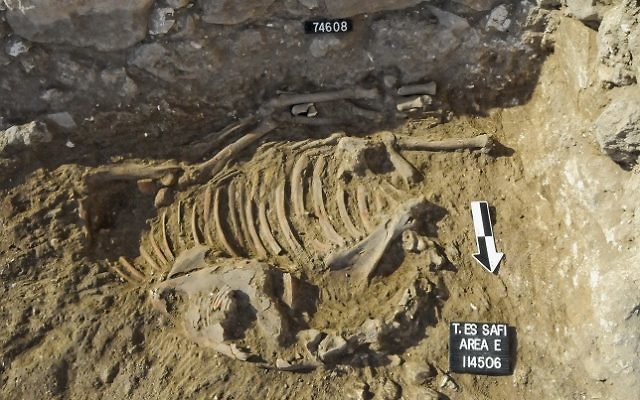A Big Bit of Equid History Uncovered in Israel
A donkey's tooth in Goliath's hometown shows bridle bits were in use long before horses arrived.

Archaeologists working in the Philistine city that was home to Goliath have found the earliest evidence of the use in the Middle East of a bridle bit to control an animal from the horse family — long before actual horses arrived in the region.
Examining the remains of a donkey sacrificed around 2700 B.C.E. in Gath (modern Tell es-Safi), the archaeologists found wear on a tooth that they believe was made by a soft bit, likely made from rope or wood.
“Only later, from the Middle Bronze Age and onward (after 2000 B.C.E.), was it thought that bits, in particular metal bits, were used — first with horses that were introduced to the Near East at the time, and subsequently with other equids, such as donkeys,” said Bar-Ilan University archaeology professor Aren Maeir, who has led the Tell es-Safi/Gath Archaeological Project for more than 20 years ago. Examples of the later bits were found in Israel at Tel Haror.
“It was commonly assumed that donkeys were controlled with nose rings, as depicted in Mesopotamian art,” Maeir said.
The international archaeological team, including the University of Manitoba (St. Paul’s College), the University of Saskatchewan (St. Thomas More College), Ariel University and Grand Valley State University, as well as Bar-Ilan, published its findings Wednesday, May 16, in the journal PLOS ONE.
“This is significant because it demonstrates how early domestic donkeys were controlled, and adds substantially to our knowledge of the history of donkey (Equus asinus) domestication and evolution of riding and equestrian technology,” said Haskel Greenfield of the University of Manitoba, the paper’s lead author. “It is also significant that it was discovered on the remains of an early domestic donkey that was sacrificed probably as an offering to protect what we interpret to be a merchant domestic residence.”

The Gath excavations take place every summer in the Tel Zafit National Park, about halfway between Jerusalem and the coastal city of Ashkelon.
The donkey in question was laid as a sacrificial offering before the construction of a house and was one of four found buried under neighborhood houses, indicating the importance of the donkey in this society, most likely as a beast of burden used in trade, the researchers said.
In a previously published study, the researchers provided evidence, based on isotopic analyses, that the donkey was born and raised in Egypt and brought to Gath in the last few months of its life.
At a time before domesticated horses were in the region, donkeys were used to pull and carry loads and were ridden, and they were transported over long distances. Using bits allowed donkey herders to control the animals more easily during their transport.



comments